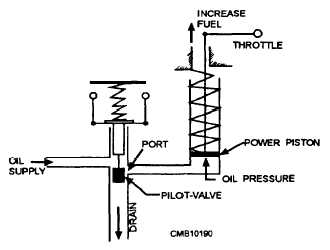giving up some of its stored energy, which moves the connecting fuel linkage to an increased delivery position. This additional fuel delivered to the combustion chambers would result in an increase in horsepower, but not necessarily an increase in engine speed.
When the truck moves into a downhill situation, the operator is forced to back off the throttle to reduce the speed of the vehicle; otherwise, the brakes or engine/transmission retarder has to be applied. The operator can also downshift the transmission to obtain additional braking power. However, when the operator does not reduce the throttle position or brake the vehicle mass in some way, an increase in road speed results. This is due to the reduction in engine load because of the additional reduction in vehicle resistance achieved through the mass weight of the vehicle and its load pushing the truck downhill. This action causes the governor weights to increase in speed, and they attempt to compress the high-speed spring, thereby reducing the fuel delivery to the engine. Engine overspeed can result if the road wheels of the vehicle are allowed to rotate fast enough that they, in effect, become the driving member.
The governor assembly would continue to reduce fuel supply to the engine due to increased speed of the engine. If overspeed does occur, the valves can end up floating (valve springs are unable to pull and keep the valves closed) and striking the piston crown. Therefore, it is necessary in a downhill run for the operator to ensure that the engine speed does not exceed maximum governed rpm by application of the vehicle, engine, or transmission forces.
Favorable, as well as unfavorable, characteristics are to be found in mechanical governors. Advantages are as follows:
They are inexpensive.
They are satisfactory when it is not necessary to maintain exactly the same speed, regardless of load.
They are extremely simple with few parts.
Disadvantages are as follows:
They have large deadbands, since the speed- measuring device must also furnish the force to move the engine fuel control.
Their power is relatively small unless they are excessively large.
They have an unavoidable speed droop, and therefore cannot truly provide constant speed when this is needed.
Hydraulic Governors
Although hydraulic governors have more moving parts and are generally more expensive than mechanical governors, they are used in many applications because they are more sensitive, have greater power to move the fuel control mechanism of the engine, and can be timed for identical speed for all loads.
In hydraulic governors (fig. 5-7), the power which moves the engine throttle does NOT come from the speed-measuring device, but instead comes from a hydraulic power piston, or servomotor. This is a piston that is acted upon by fluid pressure, generally oil under the pressure of a pump. By using appropriate piston size and oil pressure, the power of the governor at its output shaft (work capacity) can be made sufficient to operate the fuel-changing mechanism of the largest engines.
The speed-measuring device, through its speeder rod, is attached to a small cylindrical valve, called a pilot valve. The pilot valve slides up and down in a bushing, which contains ports that control the oil, flow to and from the servomotor. The force needed to slide the pilot valve is very little; a small ball head is able to control a large amount of power at the servomotor.
The basic principle of a hydraulic governor (fig. 5-7) is very simple. When the governor is operating at control speed or state of balance, the pilot valve closes the port and there is no oil flow.
When the governor speed falls due to an increase in engine load, the flyweights move in and the pilot valve

Figure 5-7. - Hydraulic governor.
Continue Reading